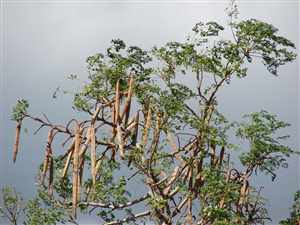Moringa (Moringa oleifera)
Main Facts about Moringa

Using Moringa
Called the "Tree of Life", very popular food, medicinal and garden tree in developing countries worldwide. All parts including bark used medicinally. Sap makes blue color dye. Leaves are most nutritious part, very high in vitamin C, beta-carotene, magnesium, calcium (good for prevention from osteoporosis and other bone conditions)and one of the highest sources of protein of any leaf: contain 18 amino acids, eight of which are essential amino acids, making them a "complete" protein - a rarity in the plant world. 25 times more iron than spinach. Seed oils very high in beneficial behenic acid. Used to increase energy and for faster recovery from workouts as well as for chronic fatigue.Used to disinfect questionable water from bacteria. Also effective against salmonella, staph, enterobacter, dysentery. Used medicinally for diabetes (controls glucose levels), Epstein-Barr, anti-fungal, anti-inflammatory, increase breast milk, better sleep, depression, anxiety, liver, kidney, thyroid, cancer, anemia, high blood pressure, migraine. Dried and powdered moringa leaves are used for skin rejuvenation.Cooking with Moringa
All parts are used. Some people use the pods in cooking, while others eat the leaves. You can additionally press oil from the seeds, or eat the roots. Roots taste like horseradish. The plant also has flowers, which are comparable to mushrooms. Leaves used for soup, tea, salads, stews, stir-fries. Immature seedpods, called "drumsticks" are edible, as are the leaves, roots, flowers, mature seeds and oil from seeds. Leaves can be used like spinach - raw, cooked, for soup, or dried and powdered. Seeds can be eaten like peas or roasted like nuts.How to grow Moringa
The trees grow best in areas where it is dry and sandy. They grow quickly and are not easily killed by a lack of water or poor soil. Morenga loves sun, does not tolerate frost.It can be produced intensively in a small garden with seeds spaced 10 cm apart. When the plants reach a height of a meter they can be cut down to a height of 30 cm. The moringa leaves can be stripped from the stems and used fresh or made into powder. The stumps survive the harvest and will re-sprout, allowing another harvest in 50 days. A moringa garden can continually produce moringa leaves for several years with little labor.| Mimosa |
Motherwort
|